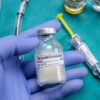CAH is in the news because of a controversial treatment used prenatally by some doctors. In some cases doctors are putting expectant women who are at risk of having a second child with CAH on dexamethasone, a synthetic male hormone, very early in pregnancy.
What is CAH (Congenital Adrenal Hyperplasia)?
The following is paraphrased from the National Adrenal Diseases Foundation
The adrenal gland makes three types of steroid hormones: cortisol (a stress hormone), aldosterone (regulates electrolyte levels) and androgens (male sex hormones). In CAH, cortisol and aldosterone production is inhibited (because of a missing enzyme 21-hydroxylase). When the body senses low levels of cortisol, the adrenal gland creates high levels of androgens. This occurs in 1 of 15,000 births. Both parents must carry the gene for CAH. Genetic testing can confirm if the parents are carriers before pregnancy.
For various reasons, this is a life threatening condition for any infant and is commonly tested for at birth with a heel prick blood test (several congenital diseases are tested for at the same time). The treatment is lifelong supplemental use of steroids. Many of the usual long term effects of steroid use won’t appear because the steroids are only replacing what is missing. There is another treatment, removing the adrenal glands completely causing a different disease, Addison’s. However, it’s not the usual treatment today.
A person with CAH usually has a normal life and can usually have their own biological children. The effects of CAH often include: abnormal growth of the clitoris in girls and masculinization of other genital-urinary structures. Boys generally have no genital malformations. In both sexes the androgen excess causes fast early body growth, but also early onset of puberty, which stops the growth prematurely. Most CAH-affected persons are of short-normal height.
What is the controversy?
Experimental prenatal therapy for CAH has been practiced using a drug called dexamethasone since 1984. It is considered experimental because dexamethasone has not been approved by the US Food & Drug Administration, or by the European regulatory agencies, for this use.
Dexamethasone (Dex) is a synthetic steroid and has been proven to cross the placental barrier. The NADF website claims that several hundred fetuses have been exposed to Dex, “and cursory surveys show no major ill effects. An expert international panel urges caution in the use of prenatal dexamethasone therapy and strict monitoring of its application by hospital institutional review boards and ethics committees. It is always prudent to consider the long-term potential for unrecognized complications when experimental therapies are used.” (www.NADF.us)
The theory is that exposing the fetus to Dex before the sex is determined, will — in the case of female infants – reduce the chance of slightly or significantly masculinized genitals. It does not cure CAH, it does not “correct” any of the other symptoms. CAH runs its course just the same and those with CAH will still have to take supplemental steroids for their entire lives.
Some research indicates that females treated with dex in the womb are less likely to be tomboys, lesbians, or have little interest in childbearing. The research was not blind, the doctors assessing behavior knew which females had been treated with dex and which had not. Further, medical treatment to direct possible future behavior is, well, scary. This is a big, wide area of unknowns.
From www.NADF.US : “Since CAH is a recessive disease, one has a 50% chance of inheriting a mutant gene from each carrier parent. The risk of an affected child is thus 25% (or 50% multiplied by 50%) in each pregnancy. Since only half of the children are female, only 1 in 8 fetuses may benefit from prenatal treatment. Thus, 7 of 8 fetuses would be exposed unnecessarily to steroid treatment via placental passage of the drug given to their mothers.”






